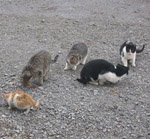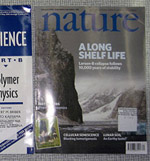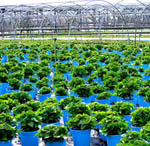The permeability of the urban landscape to wildlife movement
 Birds
Birds  I-80 in the San Francisco Bay Area. Not so permeable. Image credit, Minesweeper.
I-80 in the San Francisco Bay Area. Not so permeable. Image credit, Minesweeper.
A new study looks at roads, bridges, train tracks, and rivers as potential barriers to wildlife mobility. The researchers wanted to figure out what factors make these features more or less permeable to the movement of birds.
The concept of permeability takes on critical importance in fragmented landscapes where wildlife species often need to cross substantial distances to reach remaining habitat patches. The study found that gaps in vegetation were the most important limiting factor on whether a bird would cross transportation or riparian corridors.
Mobbing calls lure birds across the road
The researchers conducted their study in semi-natural areas within the city of Calgary. For each feature, they played a digital recording of a mobbing call from a blackcapped chickadee (Poecile attricapilus) or a red-breasted nuthatch (Sitta canadensis) to lure birds to one side - the mobbing calls of both birds are known to attract dozens of species.
The same call was then played on the other side of the feature, where observers counted the number of birds that made the crossing. They repeated this experiment at varying distances and in a variety of traffic and vegetation contexts.
Study findings...
- In areas with vegetation gaps of 45 meters, birds were half as likely to cross as they were in uninterrupted forest cover. It may be that songbirds fear predation by raptors, and so they avoid gaps in vegetation.
- Traffic volume was a negative factor for bird crossing, though less important than vegetation gap. This is consistent with other studies, which have found that traffic volume has a greater effect on the crossing of large mammals while vegetation gap is more important for smaller species such as birds.
- Railways and light transit lines were the most permeable features to bird crossing. The researchers suspect that this is likely due to their relatively narrow width and low traffic volume.
- Surprisingly, rivers were the least permeable to bird crossing. The researchers speculate that rivers may serve as natural territorial boundaries that birds are reluctant to cross.
- Not so surprising, birds were much more likely to cross over bridges than under them even when it was less direct.
So what does this mean for conservation?
While this study was conducted in an urbanized setting, the findings provide valuable information to planners on how to improve the habitat connectivity of fragmented landscapes in general. Based on the findings, the researchers give the following recommendations:
- Limiting gaps in vegetation to less than 45 meters will likely increase bird movement, especially where transportation corridors overlap with important habitat areas
- The findings give support for rail as a more sustainable form of transportation. Railways create better landscape connectivity for birds than wide, high-traffic roads.
- The bisecting of riparian corridors by roads should be minimized given that they serve as a natural conduit for birds. Also, given the findings that birds were reluctant to cross rivers, it may be important to ensure that continuous habitat exists along at least one, and preferably both sides of riparian corridors. This may allow birds to move along these features without the need to cross from one side to the other.
--Reviewed by Rob Goldstein
Tremblay, M., & St. Clair, C. (2009). Factors affecting the permeability of transportation and riparian corridors to the movements of songbirds in an urban landscape Journal of Applied Ecology DOI: 10.1111/j.1365-2664.2009.01717.x




Reader Comments